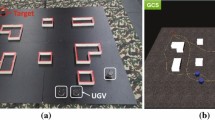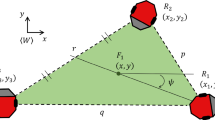Abstract
In this paper, the optimal formation and optimal matching of a multi-robot system are investigated with a projection-based algorithm designed to get the optimal formation moving in real time. The formation-related optimization problem is proposed under the consideration of two cases: the free formation and the formation with anchor(s). For the latter, equality constraints are formulated for the anchor, and the objective of the optimal formation is to minimize the total distance to the initial formation of the multi-robot system. Here, the objective function with mixed norm is considered to get a compact formation. Sufficient conditions on the design parameter for global convergence of the proposed algorithm are provided in the theoretical results. Furthermore, the projection particle swarm optimizer is investigated for getting the optimal matching between the initial/intermediate formation and the optimal formation. Finally, simulations on several numerical examples are presented to validate the effectiveness of the proposed method.









Similar content being viewed by others
References
Alonso-Mora, J., Montijano, E., Nägeli, T., Hilliges, O., Schwager, M., Rus, D.: Distributed multi-robot formation control in dynamic environments. Auton. Robot. 43(5), 1079–1100 (2019)
Anderson, B.D., Yu, C., Fidan, B., Hendrickx, J.M.: Rigid graph control architectures for autonomous formations. IEEE Control Syst. Mag. 28(6), 48–63 (2008)
Arezoumand, R., Mashohor, S., Marhaban, M.H.: Finding objects with segmentation strategy based multi robot exploration in unknown environment. Procedia - Soc. Behav. Sci. 97, 580–586 (2013)
Bazaraa, M., Sherali, H., Shetty, C.: Nonlinear programming: theory and algorithms, 3rd edn. Wiley, Hoboken (2006)
Consolini, L., Morbidi, F., Prattichizzo, D., Tosques, M.: Leader-follower formation control of nonholonomic mobile robots with input constraints. Automatica 44(5), 1343–1349 (2008)
Derenick, J.C., Spletzer, J.R.: Convex optimization strategies for coordinating large-scale robot formations. IEEE Trans. Robot. 23(6), 1252–1259 (2007)
Ding, L., Yu, P., Liu, Z.W., Guan, Z.H., Feng, G.: Consensus of second-order multi-agent systems via impulsive control using sampled hetero-information. Automatica 49(9), 2881–2886 (2013)
Ebel, H., Eberhard, P.: Optimization-driven control and organization of a robot swarm for cooperative transportation. In: Proceedings of 8th IFAC Symposium on Mechatronic Systems (MECHATRONICS 2019), vol. 52, pp. 115–120. Vienna, Austria (2019)
Ebel, H., Luo, W., Yu, F., Tang, Q., Eberhard, P.: Design and experimental validation of a distributed cooperative transportation scheme. IEEE Trans. Autom. Sci. Eng. (2020). https://doi.org/10.1109/TASE.2020.2997411
Eberhart, R., Kennedy, J.: A new optimizer using particle swarm theory. In: Proc. Sixth International Symposium on Micro Machine and Human Science, pp. 39–43 (1995)
Friesz, T., Bernstein, D., Mehta, N., Tobin, R., Ganjalizadeh, S.: Day-to-day dynamic network disequilibria and idealized traveler information systems. Op. Res. 42(6), 1120–1136 (1994)
Gregory, J., Fink, J., Stump, E., Twigg, J., Rogers, J., Baran, D., Fung, N., Young, S.: Application of multi-robot systems to disaster-relief scenarios with limited communication in field and service robotics, pp. 639–653. Springer, Cham (2016)
Hu, Q., Shi, Y.: Event-based coordinated control of spacecraft formation flying under limited communication. Nonlinear Dyn. 99(3), 2139–2159 (2020)
Kendall, D.G., Barden, D., Carne, T.K., Le, H.: Shape and shape theory. Wiley, Amsterdam (2008)
LaSalle, J.: The stability of dynamical systems. SIAM, Philadelphia (1976)
Li, W., Chen, Z., Liu, Z.: Leader-following formation control for second-order multiagent systems with time-varying delay and nonlinear dynamics. Nonlinear Dyn. 72(4), 803–812 (2013)
Liu, Q., Li, K.: A continuous-time algorithm based on multi-agent system for distributed least absolute deviation subject to hybrid constraints. In: Proc. 43rd Annual Conference of the IEEE Industrial Electronics Society, pp. 7381–7386 (2017)
Liu, Q., Wang, J.: A one-layer projection neural network for nonsmooth optimization subject to linear equalities and bound constraints. IEEE Trans. Neural Netw. Learn. Syst. 24(5), 812–824 (2013)
Liu, Q., Xu, B., Xiong, J., Zhang, W.: Projection particle swarm optimizer. In: Proceedings of IEEE International Conference on Information Science and Technology, pp. 161–168 (2017)
Liu, Q., Yang, S., Hong, Y.: Constrained consensus algorithms with fixed step size for distributed convex optimization over multiagent networks. IEEE Trans. Autom. Control 62(8), 4259–4265 (2017)
Liu, T., Jiang, Z.P.: Distributed formation control of nonholonomic mobile robots without global position measurements. Automatica 49(2), 592–600 (2013)
Michael, N., Zavlanos, M.M., Kumar, V., Pappas, G.J.: Distributed multi-robot task assignment and formation control. In: Proceedings of IEEE International Conference on Robotics and Automation, pp. 128–133 (2008)
Oh, H., Shirazi, A.R., Sun, C., Jin, Y.: Bio-inspired self-organising multi-robot pattern formation: A review. Robot. Auton. Syst. 91, 83–100 (2017)
Premvuti, S., Yuta, S.: Consideration on the cooperation of multiple autonomous mobile robots. In: Proceedings of the IEEE International Workshop of Intelligent Robots and Systems, pp. 59–63. Tsuchiura, Japan (1990)
Ren, W., Sorensen, N.: Distributed coordination architecture for multi-robot formation control. Robot. Auton. Syst. 56(4), 324–333 (2008)
Saptharishi, M., Oliver, C.S., Diehl, C.P., Bhat, K.S., Dolan, J.M., Trebi-Ollennu, A., Khosla, P.K.: Distributed surveillance and reconnaissance using multiple autonomous ATVs: cyberScout. IEEE Trans. Robot. Autom. 18(5), 826–836 (2002)
Van Parys, R., Pipeleers, G.: Distributed MPC for multi-vehicle systems moving in formation. Robot. Auton. Syst. 97, 144–152 (2017)
Wang, X., Ni, W., Wang, X.: Leader-following formation of switching multirobot systems via internal model. IEEE Trans. Syst., Man, and Cybern. - Part B: Cybern. 42(3), 817–826 (2012)
Wang, Y., Cheng, L., Hou, Z.G., Yu, J., Tan, M.: Optimal formation of multirobot systems based on a recurrent neural network. IEEE Trans. Neural Netw. Learn. Syst 27(2), 322–333 (2016)
Xia, Y.: An extended projection neural network for constrained optimization. Neural Comput. 16, 863–883 (2004)
Xiao, H., Chen, C.: Leader-follower consensus multi-robot formation control using neurodynamic-optimization-based nonlinear model predictive control. IEEE Access 7, 43581–43590 (2019)
Yao, X., Ding, H., Ge, M.: Fully distributed control for task-space formation tracking of nonlinear heterogeneous robotic systems. Nonlinear Dyn. 96(1), 87–105 (2019)
Zhao, Q., Dong, X., Song, X., Ren, Z.: Cooperative time-varying formation guidance for leader-following missiles to intercept a maneuvering target with switching topologies. Nonlinear Dyn. 95(1), 129–141 (2019)
Acknowledgements
This work was supported in part by the National Natural Science Foundation of China under Grant 61876036 and Grant 61833005 and in part by the Jiangsu Provincial Key Laboratory of Networked Collective Intelligence under Grant BM2017002.
Author information
Authors and Affiliations
Corresponding author
Ethics declarations
Conflict of interest
The authors declare that they have no conflict of interest.
Additional information
Publisher's Note
Springer Nature remains neutral with regard to jurisdictional claims in published maps and institutional affiliations.
Rights and permissions
About this article
Cite this article
Liu, Q., Wang, M. A projection-based algorithm for optimal formation and optimal matching of multi-robot system. Nonlinear Dyn 104, 439–450 (2021). https://doi.org/10.1007/s11071-020-06189-y
Received:
Accepted:
Published:
Issue Date:
DOI: https://doi.org/10.1007/s11071-020-06189-y




